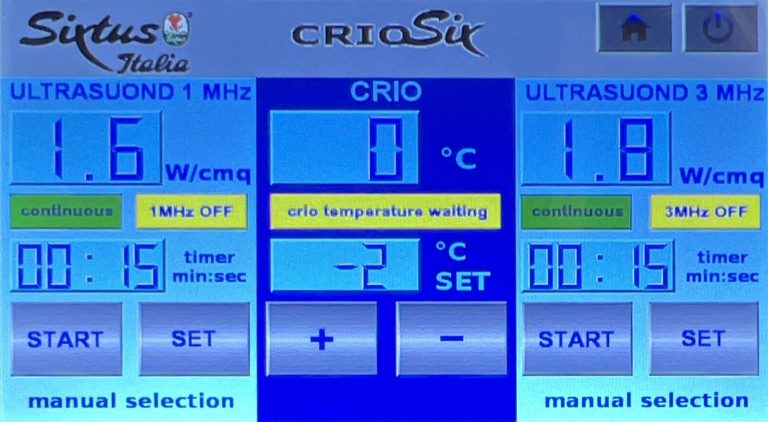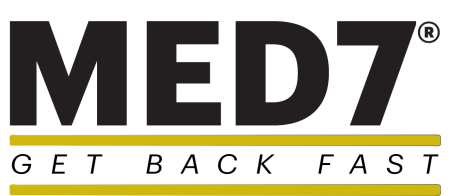FREE DELIVERY ON ALL ORDERS| TRAINING INLUDED| CHECK OUT OUR 5 ✪ RATINGS
CRYOTHERAPY
+ ULTRASOUND THERAPY

Cryoultrasound

Separately, Cryo and Ultrasound therapies have been used widely by athletes and patients for decades. By combining cryotherapy and ultrasound, Cryoultrasound is a clinically proven medical device used effectively to target muscle injuries and penetrate deep into the connective tissue layers to promote healing.

WHAT IS COLD ULTRASOUND?
The speedy recovery that cryoultrasound therapy provides for athletes was the primary factor that contributed to its early success in the sporting world. Cyro-US therapy has since made its way into traditional methods of treatment (Vulpiani et al., 2015).
Cryotherapy = analgesia and inflammatory reduction
Ultrasound = enhanced healing through growth factor promotion

WHAT IS CRYO-ULTRASOUND THERAPY?
Cryo-US therapy combines cryotherapy and therapeutic ultrasound, offering benefits like reducing edema and pain. Cryotherapy is a key part of most injury treatments. The ultrasound component uses high-frequency oscillatory sound waves with a peak pressure of 0.5 bar, significantly lower than that of a shock wave.
The internal heat created by ultrasound increases blood flow, relaxes muscles, enhances the flexibility of collagen fibers, and triggers a pro-inflammatory response. Non-thermal effects like cavitation and auditory microstreaming stimulate fibroblast activity, protein synthesis, blood flow, tissue regeneration, and bone healing.
HOW DOES CRYO-ULTRASOUND THERAPY WORK?
This therapy combines cold and ultrasound treatments to reduce pain, inflammation, and edema. Cold therapy suppresses pain receptors and restricts blood flow, controlling edema and providing pain relief. Ultrasound generates high-frequency sound vibrations that produce mechanical, thermal, chemical, and cavitation effects, aiding in tissue healing and reducing inflammation. Ultrasound also improves vascularization and removes inflammatory molecules. The combination of these therapies provides deep micromassage and a calming effect on damaged tissues (Paoloni et al., 2015).

ADVANTAGES OF CRYO-ULTRASOUND THERAPY?
- MUSCLE RECOVERY
- IMPROVED SLEEPING
- CHRONIC PAIN RELIEF
When your body encounters cooler temperatures, it initiates vasoconstriction, narrowing blood vessels and directing blood toward your organs. This process concentrates oxygen and nutrients in the blood. As the body warms up, vasodilation occurs, widening the blood vessels and returning oxygen-rich blood to the tissues, which helps flush out inflammation and toxins, aiding in recovery.
Cryo-US therapy alleviates chronic pain by slowing nerve impulse transmission, a known effect of cold temperatures. Cryotherapy has also been shown to improve sleep quality by reducing muscle inflammation and damage, and it activates the sympathetic nervous system, which plays a role in the sleep process.
Cryotherapy is commonly used to accelerate the healing of muscles and tissues after physical activity or injury. This is based on the physiological changes that occur in the body in response to exposure to cold and hot temperatures.
Cryo in action
CrioSix is used by a large number of sporting teams and premium clinics around the world.


September 2023
“instant relief for the patient great for rebookings”

CRYO-ULTRASOUND THERAPY CLINICAL STUDIES?
1. Vulpiani et al. (2015) and Vural et al. (2014) found that cryo-ultrasound therapy effectively combines therapeutic ultrasound and cryotherapy, improving recovery and pain relief. Cryotherapy reduces the thermal impact of ultrasound, allowing patients to benefit from both treatments' mechanical and biological effects. This combination enhances the overall effectiveness of the therapy, as the reduction in deep tissue temperature increases the density of ultrasound waves.
2. Costantino et al. (2014) found that cryo-ultrasound therapy is effective for treating persistent plantar fasciitis, providing long-lasting pain relief and improved function. The combination of cryotherapy and ultrasound enhances tissue healing and reduces inflammation, making it a valuable option for chronic conditions.
3. Liu et al. (2019), evaluated cryo-ultrasound therapy for its effectiveness in treating chronic shoulder tendinopathy. The study found that patients receiving cryo-ultrasound therapy showed significant improvement in pain reduction and functional outcomes compared to those receiving standard treatments.
Enquire About Cryo-ultrasound Therapy
REFERENCES
AMMENDOLIA, A., DE SIRE, A., LIPPI, L., AMMENDOLIA, V., SPANÒ, R., REGGIANI, A., INVERNIZZI, M. & MAROTTA, N. 2023. Cryo plus Ultrasound Therapy, a Novel Rehabilitative Approach for Football Players with Acute Lateral Ankle Injury Sprain: A Proof-of-Concept Study. Sports, 11, 180.
BLEAKLEY, C., MCDONOUGH, S. & MACAULEY, D. 2004. The use of ice in the treatment of acute soft-tissue injury: a systematic review of randomised controlled trials. The American journal of sports medicine, 32, 251-261.
CHAO, Y.-H., TSUANG, Y.-H., SUN, J.-S., CHEN, L.-T., CHIANG, Y.-F., WANG, C.-C. & CHEN, M.-H. 2008. Effects of shock waves on tenocyte proliferation and extracellular matrix metabolism. Ultrasound in medicine & biology, 34, 841-852.
CHEN, Y. J., WANG, C. J., YANG, K. D., KUO, Y. R., HUANG, H. C., HUANG, Y. T., SUN, Y. C. & WANG, F. S. 2004. Extracorporeal shock waves promote healing of collagenase‐induced Achilles tendinitis and increase TGF‐β1 and IGF‐I expression. Journal of Orthopaedic Research, 22, 854-861.
COSTANTINO, C., POGLIACOMI, F. & VAIENTI, E. 2005. Cryoultrasound therapy and tendonitis in athletes: a comparative evaluation versus laser CO2 and te ca. r. therapy. Acta Biomed, 76, 37-41.
COSTANTINO, C., VULPIANI, M., ROMITI, D., VETRANO, M. & SARACENI, V. 2014. Cryoultrasound therapy in the treatment of chronic plantar fasciitis with heel spurs. A randomized controlled clinical study. Eur J Phys Rehabil Med, 50, 39-47.
DE NARDI, M., BISIO, A., DELLA GUARDIA, L., FACHERIS, C., FAELLI, E., LA TORRE, A., LUZI, L., RUGGERI, P. & CODELLA, R. 2021. Partial-body cryostimulation increases resting energy expenditure in lean and obese women. International Journal of Environmental Research and Public Health, 18, 4127.
DOUZI, W., DUPUY, O., THEUROT, D., BOUCARD, G. & DUGUÉ, B. 2019. Partial-body cryostimulation after training improves sleep quality in professional soccer players. BMC Research Notes, 12, 1-5.
GARCIA, C., KARRI, J., ZACHARIAS, N. A. & ABD-ELSAYED, A. 2021. Use of cryotherapy for managing chronic pain: an evidence-based narrative. Pain and therapy, 10, 81-100.
KLIMENKO, T., AHVENAINEN, S. & KARVONEN, S.-L. 2008. Whole-body cryotherapy in atopic dermatitis. Archives of dermatology, 144, 806-808.
LARSEN, A., KRISTENSEN, G., THORLACIUS-USSING, O. & OXLUND, H. 2005. The influence of ultrasound on the mechanical properties of healing tendons in rabbits. Acta orthopaedica, 76, 225-230.
LEONE, L., VETRANO, M., RANIERI, D., RAFFA, S., VULPIANI, M. C., FERRETTI, A., TORRISI, M. R. & VISCO, V. 2012. Extracorporeal shock wave treatment (ESWT) improves in vitro functional activities of ruptured human tendon-derived tenocytes. PloS one, 7, e49759.
PAOLONI, M., TAVERNESE, E., CACCHIO, A., D’ORAZI, V., IOPPOLO, F., FINI, M., SANTILLI, V. & MANGONE, M. 2015. Extracorporeal shock wave therapy and ultrasound therapy improve pain and function in patients with carpal tunnel syndrome. A randomized controlled trial. Eur J Phys Rehabil Med, 51, 521-8.
QU, C., WU, Z., XU, M., LORENZO, S., DONG, Y., WANG, Z., QIN, F. & ZHAO, J. 2022. Cryotherapy on Subjective Sleep Quality, Muscle, and Inflammatory Response in Chinese Middle-and Long-Distance Runners After Muscle Damage. Journal of Strength and Conditioning Research, 36, 2883-2890.
TSAI, W. C., PANG, J. H. S., HSU, C. C., CHU, N. K., LIN, M. S. & HU, C. F. 2006. Ultrasound stimulation of types I and III collagen expression of tendon cell and upregulation of transforming growth factor β. Journal of orthopaedic research, 24, 1310-1316.
VISCO, V., VULPIANI, M. C., TORRISI, M. R., FERRETTI, A., PAVAN, A. & VETRANO, M. 2014. Experimental studies on the biological effects of extracorporeal shock wave therapy on tendon models. A review of the literature. Muscles, ligaments and tendons journal, 4, 357.
VULPIANI, M. C., NUSCA, S. M., VETRANO, M., OVIDI, S., BALDINI, R., PIERMATTEI, C., FERRETTI, A. & SARACENI, V. M. 2015. Extracorporeal shock wave therapy vs cryoultrasound therapy in the treatment of chronic lateral epicondylitis. One year follow up study. Muscles, Ligaments and Tendons Journal, 5, 167.
VURAL, M., DIRACOGLU, D., ERHAN, B., GUNDUZ, B., OZHAN, G. & PEKEDIS, K. 2014. Efficacy of extracorporeal shock wave therapy and ultrasound treatment in lateral epicondylitis: A prospective, randomized, controlled trial. Annals of Physical and Rehabilitation Medicine, e190.
We need your consent to load the translations
We use a third-party service to translate the website content that may collect data about your activity. Please review the details in the privacy policy and accept the service to view the translations.
